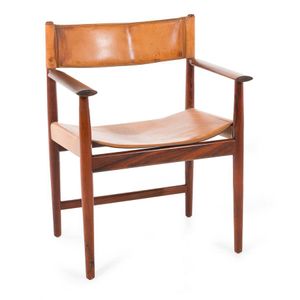Prince of Wales Investiture Chair with Original Documentation
You must be a subscriber, and be logged in to view price and dealer details.
Subscribe Now to view actual auction price for this item
When you subscribe, you have the option of setting the currency in which to display prices to $Au, $US, $NZ or Stg.
- Prince of Wales Feathers - The triple plumed crest of the Prince of Wales, from the 114th century, showing three ostrich feathers surmounting a crown. The motif was adopted in the 18th and early 19th century in various stylised forms by wood carvers and furniture designers.
- Gilding - Gilding is a method of ornamentation whereby a thin sheet of gold metal is applied to items made of wood, leather, ceramics, glass and silver for decorative purposes.
For furniture including mirrors, the sheet of gold is usually applied over a coating of gesso. Gesso is a mixture of plaster of Paris and gypsum mixed with water and then applied to the carved wooden frames of mirrors and picture frames as a base for applying the gold leaf. After numerous coats of gesso have been applied, allowed to dry and then sanded a coat of "bole", a usually red coloured mixture of clay and glue is brushed on and allowed to dry, after which the gold leaf is applied. Over time parts of the gilding will rub off so the base colour can be seen. In water gilding, this was generally a blue colour, while in oil gilding, the under layer was often yellow. In Victorian times, gilders frequently used red as a pigment beneath the gold leaf.
Metal was often gilded by a process known as fire gilding. Gold mixed with mercury was applied and heated, causing the mercury to evaporate, the long-term effect of which was to kill or disable the craftsman or woman from mercury poisoning. The pursuit of beauty has claimed many victims, not the least of which were the artists who made those pieces so highly sought after today.
This item has been included into following indexes:
Visually similar items

Prince of Wales Investiture chair, c. 1969, vermillion stained beech, the back with gilded Prince of Wales feathers, height 78 cm. Provenance: The chair was designed by the Earl of Snowdon for the Prince of Wales' Investiture in July 1969 at Carnavon Castl

An Illum Wikellso armchair and ottoman. C. 1960s Denmark. Manufactured by Niels Eilersen. Teak, new upholstery, Ficus 'Paua' by Mokum for James Dunlop - viscose, cotton and linen blend

Fred Ward (1899-1990), set of four Queensland walnut chairs from hall, University house, Australian National University, Canberra, A.C.T., 1953 manufactured by Alfons Stuetz and Oswald Paseka, Canberra furniture manufacturers, Fyshwick, A.C.T., second gene

Mid century armchair, Distressed tan leather, Denmark, c 1960s, 80 cm high, 61 cm wide, 53 cm deep
